In June of 2015, the Donner Summit Public Utility District (DSPUD) completed a $24 million renovation project, which involved replacing the chlorine gas disinfection process with UV (ultraviolet) disinfection and tertiary treatment with membrane bioreactors (MBR), a highly sophisticated filtration process used for final wastewater cleaning. The MBR process uses membrane filters with a combination of microfiltration. Using pumps, the effluent is pulled through membranes that filter out the last final particles before the final UV treatment.
The new UV disinfection system uses ultraviolet light to further treat effluent. The final result is tertiary treated, pathogen-free, crystal clear recycled water that meets or exceeds Title 22 requirements making it effectively cleaner than surface water.
With the new improvements, DSPUD’s wastewater treatment plant can now process up to 1.27 MGD on a peak day and in all weather conditions.
Click on the map below for a virtual tour of Donner Summit’s technologically advanced wastewater treatment plant and read about the various wastewater treatment plant functions.
Treatment plant interactive map
WWTP map
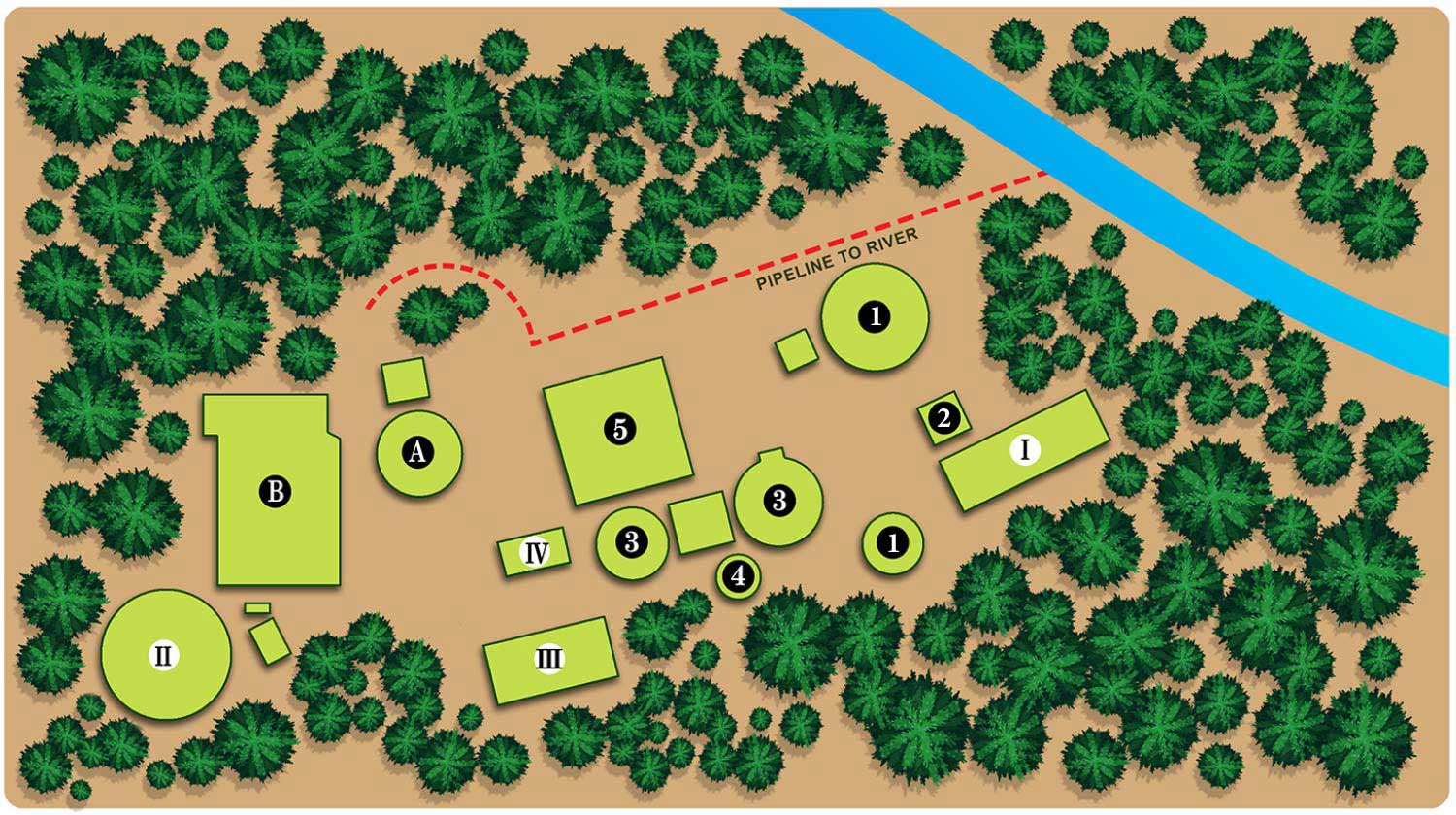
1. Equalization Tanks

Goal: Reduce and neutralize toxic compounds in the wastewater
Equalization tanks balance several critical factors in the wastewater treatment so the biological processes function with maximum effectiveness. The bugs that eat the waste in later stages are finicky and need to be fed just the right amount of nutrients to keep their growth and die-off in a manageable state. EQ tanks manage rate of flow, organic concentration of wastewater and maintain a neutral pH.
The new EQ tank can handle 750,000 gallons of wastewater per day. Coupled with the existing tank, which holds 200,000 gallons, the plant has the capacity to hold close to1 million gallons of raw wastewater.
1. Equalization Tanks

Goal: Reduce and neutralize toxic compounds in the wastewater
Equalization tanks balance several critical factors in the wastewater treatment so the biological processes function with maximum effectiveness. The bugs that eat the waste in later stages are finicky and need to be fed just the right amount of nutrients to keep their growth and die-off in a manageable state. EQ tanks manage rate of flow, organic concentration of wastewater and maintain a neutral pH.
The new EQ tank can handle 750,000 gallons of wastewater per day. Coupled with the existing tank, which holds 200,000 gallons, the plant has the capacity to hold close to1 million gallons of raw wastewater.
2. Headworks
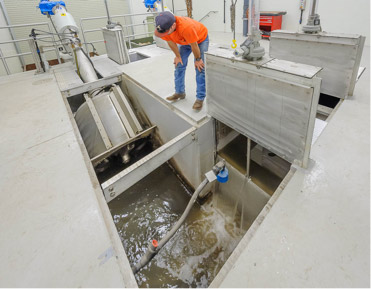
Goal: Remove large solids from wastewater as it enters the wastewater treatment plant.
Raw sewage from domestic and commercial sources enters the treatment plant at the headworks. Large inorganic solids in the waste stream (rags, garbage, etc.) are filtered out through drum style bar screens. This process also manages the flow of wastewater in the system and protects equipment from clogging or breaking due to large debris.
Debris is cleaned of organic matter and taken to a landfill. The screened wastewater is then fed into the main treatment process.
3. Reactor Basins I and II

Goal: Break down nutrients from influent
The reactor basins have a "flow through" system, with raw wastewater (influent) coming in at one end and treated water (effluent) flowing out the other to the membrane filtration tanks.
Influent from the equalize tanks is routed to the reactor basins where microorganisms are introduced that will eat and digest the solid matter in the effluent. This process is Activated Sludge. Microorganisms mix in with organic material in the wastewater and grow by using the organics as food. As the microorganisms grow and combine with oxygen, the individual organisms clump together (flocculate) to form an active mass of microbes called "activated sludge."
The activated sludge (a thick mud-like material) pulled out of the wastewater is made up of the now fat and well-fed microorganisms. This sludge is taken to drying beds to evaporate excess moisture, making it easier and lighter to transport to a landfill.
3. Reactor Basins I and II

Goal: Break down nutrients from influent
The reactor basins have a "flow through" system, with raw wastewater (influent) coming in at one end and treated water (effluent) flowing out the other to the membrane filtration tanks.
Influent from the equalize tanks is routed to the reactor basins where microorganisms are introduced that will eat and digest the solid matter in the effluent. This process is Activated Sludge. Microorganisms mix in with organic material in the wastewater and grow by using the organics as food. As the microorganisms grow and combine with oxygen, the individual organisms clump together (flocculate) to form an active mass of microbes called "activated sludge."
The activated sludge (a thick mud-like material) pulled out of the wastewater is made up of the now fat and well-fed microorganisms. This sludge is taken to drying beds to evaporate excess moisture, making it easier and lighter to transport to a landfill.
4. Lime Feeder Silo
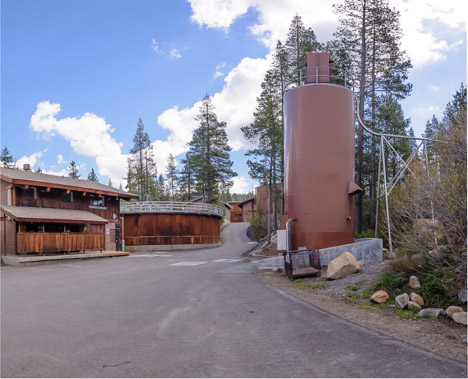
Goal: Used for pH adjustment and sludge conditioning.
5. Membrane Filtration

Goal: Disinfect wastewater by removing remove particles, colloids and macromolecules, creating effluent safe for river discharge.
The remaining effluent enters the filters and leaves looking like clear water. This process involves the use of membrane filters - a combination of microfiltration.
Filtration Membrane
DSPUD's plant uses a highly sophisticated filtration process for final wastewater cleaning. Using pumps, the effluent is pulled through membranes that filter out the last final particles. These are settled out to the bottom and moved into the sludge process. The filtered effluent is now ready for final disinfection with ultraviolet light.
A. Sludge Storage Tank
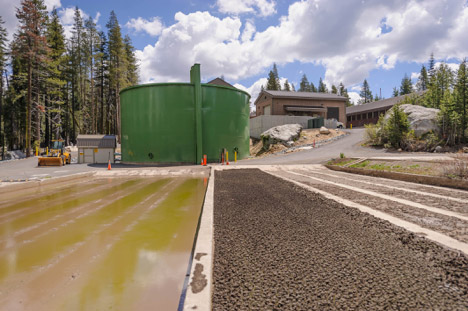
Goal: Sludge storage tank holds the solids removed during the treatment process.
B. Sludge Drying Beds

Goal: Excess moisture is evaporated from sludge before being transported to a landfill.
I. Administration
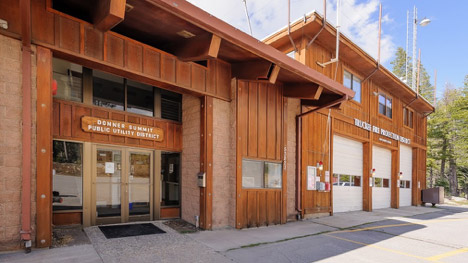
The administration building is home to DSPUD's friendly personnel.
II. Emergency Storage Tank/Irrigation Storage

Goal: Emergency storage of water
In the winter time and during peak ski season, the emergency storage tank is used to store effluent during plant upsets that could harm the quality of the receiving water (influent). It is also destined to serve as storage for effluent that is used in snow making. During summer months, the tank is used to store effluent designated to be sprayed on the land application site.
III. Supervisory Control and Data Acquisition (SCADA) Personnel Office and Equipment Storage

Goal: Remotely control plant functions
The SCADA system allows operators the ability to control most plant operations from a remote location. The system uses cutting-edge computer technology to collect, store and process information from the wastewater treatment plant. Current information can be compared to historic system information and informed decisions can be made quickly.
The building is also the home to DSPUD personnel and is used for vehicle storage.
IV: Electrical and Chemical Building
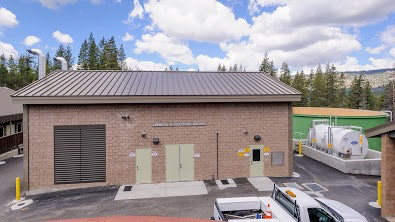
Goal: Houses the electrical system and various chemicals used throughout the plant.
The electrical/chemical building houses the electrical system and various chemicals used in plant processes. The electrical system controls the multitude of the plant's components in operation throughout the treatment process. The stand-by generators are also stored in this building and are used when power outages occur. The building holds the chemicals that are used to provide artificial nutrients when the influent lacks such nutrients.
